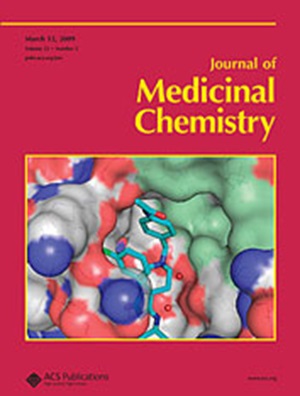99mTc-Labeled Quinolone-Based Novel Skeletal Tracers for Tumor Visualization through Fibroblast Activation Protein
IF 6.8
1区 医学
Q1 CHEMISTRY, MEDICINAL
引用次数: 0
Abstract
Fibroblast activation protein (FAP) has emerged as a prominent target for tumor diagnosis. Quinoline-based FAP PET tracers demonstrated clinical feasibility. However, there is a relative scarcity of clinical studies on 99mTc-labeled FAP SPECT tracers. The existing quinoline-derived 99mTc-FAPI tracer exhibits relatively low tumor uptake and suboptimal pharmacokinetic properties, which restrict its clinical application. Consequently, it is necessary to alter the pharmacophores to improve its druggability. In this study, a novel quinolone-based pharmacophore was developed by utilizing scaffold hopping and conformational constrained strategies. Serial screening and preclinical evaluations were conducted. The 99mTc-FAPI-YQ3 showed extremely high tumor uptake and excellent pharmacokinetic properties. Additionally, 99mTc-FAPI-YQ3 demonstrated reliable safety characteristics and clinical efficacy on four different oncology patients. In conclusion, 99mTc-FAPI-YQ3 was a promising radiotracer for FAP-targeted cancer diagnosis, shedding light on substantially advancing SPECT molecular imaging.

求助全文
约1分钟内获得全文
求助全文
来源期刊

Journal of Medicinal Chemistry
医学-医药化学
CiteScore
4.00
自引率
11.00%
发文量
804
审稿时长
1.9 months
期刊介绍:
The Journal of Medicinal Chemistry is a prestigious biweekly peer-reviewed publication that focuses on the multifaceted field of medicinal chemistry. Since its inception in 1959 as the Journal of Medicinal and Pharmaceutical Chemistry, it has evolved to become a cornerstone in the dissemination of research findings related to the design, synthesis, and development of therapeutic agents.
The Journal of Medicinal Chemistry is recognized for its significant impact in the scientific community, as evidenced by its 2022 impact factor of 7.3. This metric reflects the journal's influence and the importance of its content in shaping the future of drug discovery and development. The journal serves as a vital resource for chemists, pharmacologists, and other researchers interested in the molecular mechanisms of drug action and the optimization of therapeutic compounds.
 求助内容:
求助内容: 应助结果提醒方式:
应助结果提醒方式:


